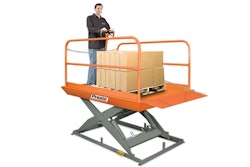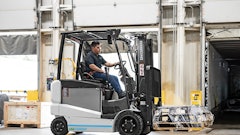
Within the global supply chain, one of the most basic but vital tools used all day every day are pallets and pallet racking. When not used correctly, however, they can pose a significant hazard. Common injuries resulting from incorrect use of pallets include sprained ankles, puncture wounds and broken toes. When used for a purpose that is unapproved, such as a man lift, the results can be fatal.
It is estimated that there are as many as 2 billion pallets in circulation throughout the United States, so it is imperative that handlers understand pallet safety and take precautionary measures to avoid incident.
Here is a thorough list of safety considerations for working with pallets.
Never use pallets as a man lift
The only thing that should be used as a man lift is an engineered lift platform approved for this purpose. It should also only be used once you have been signed off as having completed the necessary training. Whilst pallets may be designed to hold considerable weight (2,800 pounds or more), this guide is related only to loads distributed uniformly, not specifically localized loads such as in the case of a standing worker.
Exercise caution when standing on a pallet
In the event that you are temporarily standing on a pallet, exercise extreme caution. If the deck boards were to break or if your foot were to get caught between the boards, you could be significantly injured. Some pallet designs may also be prone to tipping.
Do no stand empty pallets on their end
When empty pallets are left standing on their end, they are unstable and could easily cause an injury if they were to tip over and land on a foot or leg.
Always use protective equipment when handling
When working with pallet racking, it’s important to use the advised personal protective equipment (PPE), including gloves and standard safety shoes to protect you from injury in the event of a pallet falling on your foot. It may also be prudent to use hearing protection if pallets are often being dropped. Some facilities do follow protocol to ensure soft landings when pallets are being placed on the floor to avoid auditory damage to workers.
Step between pallets with care
Pallets positioned in storage racks side by side can cause workers to need to step between them, or perhaps onto a pallet to reach a product behind the pallet. Knee and ankle injuries are common in workers who lose their balance when making these moves, so take care if you need to traverse pallets in this way.
Do not use inappropriate or damaged pallets
If a pallet is an inappropriate design for the task, or otherwise damaged, they should be removed from the workplace. If you come across one, set it aside for either repair or recycling to avoid them being used. Damaged pallets can pose a serious hazard, especially when used for high loads and at height.
Limit the height of stacked pallets
When pallets are being stacked manually, maintain a maximum stacking height of 4 feet to ensure that pallet handling remains safe. Past this point, organize for a forklift operator to separate any full stacks into halves before manually handling or unstacking.
Clean up pallet debris straight away
Common pallet-related slip and trip hazards are broken pallet boards left lying around. They can also cause material handling equipment to become unstable, or damage equipment wheels, so clear up any pallet debris immediately.
Use pick hooks to reach behind pallets
It is best to avoid stepping on pallets, so if you do need to reach for a product at the back of a pallet, utilize a pick hook to pull it forward. This will prevent the tipping of a pallet due to an imbalance of weight placed on it.
Take extreme caution when manually lifting pallets
The weight of pallets varies greatly - from as light as 30 pounds to as much as 70 pounds or more. Lightweight pallets have some applications that enable an individual employee to easily lift it. Heavier pallets, however, are more commonly used and care must be taken when moving them. Unless a machine such as a forklift can be used, employees should work together to lift them jointly and follow standard occupational health and safety guidelines for safe lifting practices.
Working with pallets is a very common practice for many workplaces. Whilst working with them safely may seem like common sense, it is important to ensure that all aspects of working safely with pallets are being adhered to and all necessary precautionary measures are always taken.



















